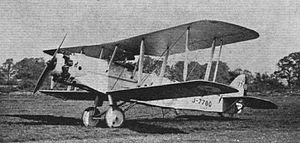De Havilland Hyena Video -
|
|
De Havilland Hyena
DH.56 Hyena

Picture - The DH.56 Hyena J-7780
Role: Army cooperation aircraft
National origin: United Kingdom
Manufacturer: de Havilland
First flight: 17 May 1925
Number built: 2
Developed from: de Havilland DH.42B Dingo II
The de Havilland DH.56 Hyena was a prototype British army co-operation aircraft of the 1920s. A single engined biplane, the Hyena was designed against an RAF requirement, but was unsuccessful with only two being built, the Armstrong Whitworth Atlas being preferred.
Development and design
The DH.56 Hyena was developed to met the requirements of Air Ministry Specification 30/24 for an Army Co-operation aircraft to equip Britain's Royal Air Force. It was a development of de Havilland's earlier DH.42B Dingo, and like the Dingo, was a single-engined two-bay biplane carrying a crew of two. It was armed with a forward firing Vickers machine gun and a Lewis gun operated by the observer. A hook to pick up messages was fitted beneath the fuselage, while the aircraft was also equipped for photography, artillery spotting, supply dropping and bombing.
The first Hyena flew on 17 May 1925, powered by a 385hp (287kW) Armstrong Siddeley Jaguar III radial engine. With this engine it was underpowered, and was quickly re-engined with a 422hp (315kW) Jaguar IV before it was submitted for official testing (which was against the requirements of Specification 20/25, which had superseded 30/24). The two prototype Hyenas were tested against the other competitors for the RAF's orders, the Armstrong Whitworth Atlas, the Bristol Bloodhound and the Vickers Vespa, including field evaluation with No. 4 Squadron RAF. Handling close to the ground was found to be difficult, with a poor view from the cockpit, and the orders went to the Atlas, with the Hyena being abandoned, being used for testing at the Royal Aircraft Establishment, Farnborough until 1928.
Specifications (Jaguar IV)
Data from De Havilland Aircraft since 1909
General characteristics
Crew: 2
Length: 29 ft 9 in (9.07 m)
Wingspan: 43 ft 0 in (13.11 m)
Height: 10 ft 9 in (3.28 m)
Wing area: 421.25 ft² (39.1 m²)
Empty weight: 2,399 lb (1,090 kg)
Loaded weight: 4,200 lb (1,909 kg)
Powerplant: 1x— Armstrong Siddeley Jaguar IV 14-cylinder air-cooled radial engine, 422 hp (315 kW)
Performance
Maximum speed: 130 mph (113 knots, 209 km/h)
Service ceiling: 19,230 ft (5,860 m)
Climb to 10,000 ft (3,050 m): 13 min 24 sec
Armament
Guns: 1x— forward firing .303 in (7.7 mm) Vickers machine gun and 1 x— .303 in (7.7 mm) Lewis Gun on Scarff ring in rear cockpit
Bombs: Four light bombs under port wing
Related development
de Havilland Dingo
Comparable aircraft
Armstrong Whitworth Atlas
Bristol Boarhound
Vickers Vespa
Jackson, A.J. De Havilland Aircraft since 1909. London:Putnam, Third edition 1987. ISBN 0 85177 802 X.
Mason, Francis K. The British Bomber since 1914. London:Putnam, 1994. ISBN 0 85177 861 5.
Living Warbirds: The best warbirds DVD series.
Source: WikiPedia